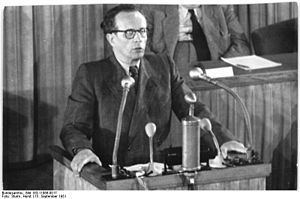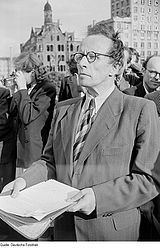Role Politician | Awards Name Vincenz Muller | |
 | ||
Allegiance German Empire (to 1918) Weimar Republic (to 1933) Nazi Germany (to 1944) NKFD (to 1945) German Democratic Republic Battles/wars World War IWorld War II Similar People Kurt von Tippelskirch, Walter Model, Dietrich von Saucken, Georgiy Zakharov, Ivan Bagramyan | ||
Years of service 1908–45; 1952–58 | ||
Vincenz Müller (5 November 1894, Aichach, Bavarian Swabia – 12 May 1961) was a military officer and general who served in the German army, the Army of Nazi Germany, and after the war in the National People's Army of the (East) German Democratic Republic, where he was also a politician.
Contents
Early career
Müller was born in the Kingdom of Bavaria into a non-military family, being the son of a tanner. He completed high school at the Metten Abbey gymnasium. As a lieutenant he spent much of World War I in Turkey with the German military mission to the Ottoman Empire. He was wounded by a grenade fragment at Gallipoli, and was then transferred to Baghdad and the Persian Front, returning to Germany after contracting malaria and typhus. In 1917 he returned to Turkey as a tactics instructor for Turkish officers.

After the war, he continued to serve with the Reichswehr in a variety of staff roles and was promoted to captain.
Nazi Germany
After Hitler's appointment as chancellor on 30 January 1933, Müller served from 1933 to 1935 as head of the construction of the mobilization system in the General Staff of the Military District Command VII, in Munich. His top superior was Lieutenant General Wilhelm Adam. He then worked until 1937 as head of the mobilization in German General Staff of the army. After visiting the Wehrmacht Academy, Müller served from 1938 to 1940 as First General Staff Officer (Ia) of Army Group 2, in Kassel. During this time he was promoted to Colonel. During this period, he is known to have had some contact with the conservative anti-Nazi resistance in the army through Erwin von Witzleben, but did not commit himself as an active plotter.
If his political affiliations remained unclear, Müller showed complete willingness to serve the Nazis' military plans and advance his Wehrmacht career. As a staff officer he was involved in planning Operation Tannenbaum, the aborted 1940 invasion of Switzerland, and Operation Barbarossa, the invasion of the Soviet Union. By 1943, Müller had become a lieutenant-general and was given command of the 56th Infantry Division, part of Fourth Army of Army Group Centre. By 1944 Müller was commander of XII Corps.
Müller found himself thrust into prominence during events in the Belorussian SSR in late June 1944. Along with the rest of Fourth Army, the XII Corps was encircled east of Minsk by Soviet forces during the latter's strategic offensive, Operation Bagration. Müller's corps was probably the least-damaged of the trapped forces, and on 3 July he was given overall command of the encircled units of Fourth Army, around 100,000 troops, which by 5 July were as much as 100 km behind Soviet lines. Despite signalling by radio that he was confident that a breakout could be achieved, Müller, who had joined the breakout attempt of the 18th Panzergrenadier Division, was captured by 8 July and most of Fourth Army was destroyed.
Soviet captivity
Müller showed a willingness to cooperate with the Soviets from the time of his capture, issuing an order to troops of the Fourth Army to lay down their weapons.
During his time as a POW Müller had an apparent change of views and professed to have become an anti-Nazi: within days of his capture he had joined the National Committee for a Free Germany and the Bund Deutscher Offiziere led by Walther von Seydlitz-Kurzbach. He was one of a group of generals captured during Operation Bagration (including Edmund Hoffmeister, the commander of XXXXI Panzer Corps, and Rudolf Bamler of the 12th Infantry Division) who became especially prominent in NKFD activity. Unlike many of his colleagues, however, Müller claimed to have become a staunch Communist. Along with Bamler, Müller is known to have attended special training in Krasnogorsk late in 1944, and is believed to have been recruited by the Soviet secret services to spy on fellow NKFD members, such as Friedrich Paulus.
The German Democratic Republic
Vincenz Müller was released relatively early from Soviet captivity, in 1948, and joined the National Democratic Party of Germany, the NDPD. From 1949 to 1952 he was the party's deputy chairman and was Vice-President of the East German parliament, the Volkskammer. During this period he is believed to have continued to act as an informant for East German state security.
After 1952, Vincenz Müller returned to a military career and was given the responsibility of reconstructing East Germany's armed forces; he was returned to the rank of Lieutenant-General. After heading the Ministry of the Interior, and successfully developing the Volkspolizei, he was appointed the Chief of Staff of the newly formed National People's Army - effectively the second-in-command of the East German military behind Willi Stoph. Müller's later career is perhaps the most significant example of the East German regime's use of former Nazis and military officers, the so-called Ehemaligen, in reconstructing its state apparatus. He was, however, known to be in favour of the independence of the NVA from the Soviet military, and to have maintained some contacts in the West through military and Bavarian circles (Western intelligence services in fact attempted to persuade Müller to defect during this period). He is also known to have conducted secret discussions with the West German Finance Minister, Fritz Schäffer, on a possible détente between East and West Germany.
After being gradually sidelined, Müller retired in 1958 amidst longstanding concerns over his loyalty to the East German administration, and came under increasing pressure from the Stasi. He was said to be suffering from schizophrenia, and was hospitalised for a period in 1960; allegations also resurfaced that he had been involved in the mass killing of Jews in Artemovsk and the shooting of POWs. He died in 1961, in somewhat controversial circumstances, as he fell from the balcony of his home on the day he was scheduled to return to hospital; it was rumoured that he had committed suicide when a police vehicle drew up outside.
A posthumous autobiography, Ich fand das wahre Vaterland (English: I found the true fatherland), was published in 1963, edited by Klaus Mammach, a SED historian.
